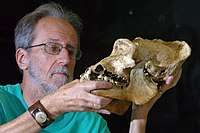Colin Groves
| Colin Groves | |
|---|---|
 | |
| Born |
24 June 1942 England |
| Died |
November 30, 2017 (aged 75) Canberra |
| Residence | Canberra |
| Alma mater |
University College London (B.Sc.) Royal Free Hospital School of Medicine (Ph.D.) |
| Known for | Biological classification of Homo ergaster |
| Scientific career | |
| Fields |
Biological Anthropology Palaeoanthropology Biogeography Primatology Mammal classification |
| Institutions |
Australian National University University of California, Berkeley Queen Elizabeth College University of Cambridge |
Colin Peter Groves (24 June 1942 – 30 November 2017) was Professor of Biological Anthropology at the Australian National University in Canberra, Australia.[1]
Born in England, Groves completed a Bachelor of Science at University College London in 1963, and a Doctor of Philosophy at the Royal Free Hospital School of Medicine in 1966. From 1966 to 1973, he was a Postdoctoral Researcher and Teaching Fellow at the University of California, Berkeley, Queen Elizabeth College and the University of Cambridge. He emigrated to Australia in 1973 and joined the Australian National University, where he was promoted to full Professor in 2000[2] and remained Emeritus Professor until his death[3].
Professor Groves' research interests included human evolution, primates, mammalian taxonomy, skeletal analysis, biological anthropology, ethnobiology, cryptozoology, and biogeography.[2] He conducted extensive fieldwork in Kenya, Tanzania, Rwanda, India, Iran, China, Indonesia, Sri Lanka and the Democratic Republic of Congo.
Along with the Czech biologist Professor Vratislav Mazák, Groves was the describer of Homo ergaster.[4] Groves also wrote Primate Taxonomy published by the Smithsonian Institution Press in 2001, and Ungulate Taxonomy, co-authored by Peter Grubb (2011, Johns Hopkins Press).
He was an active member of the Australian Skeptics and had many published skeptical papers, as well as research papers covering his other research interests.[5] He also conducted regular debates with creationists and anti-evolutionists.[5]
Bibliography
- Groves, Colin (1989). A theory of human and primate evolution. Oxford Science Publications.
- Groves, C (1989). Laycock, D, ed. Skeptical, a handbook on pseudoscience and the paranormal. Australian Skeptics. ISBN 0-7316-5794-2.
- Groves, C (1996). "From Ussher to Slusher; from Archbish to Gish; or, not in a million years..." Archaeology in Oceania. 31: 145–151.
- Groves, C (2001). Primate Taxonomy. Washington D.C.: Smithsonian Institution Press. ISBN 1-56098-872-X.
- Cameron, DW; Groves C (2004). Bones, Stones and Molecules. Boston: Elsevier. p. 402. ISBN 0-12-156933-0.
- Groves, C (2008). Extended Family: Long Lost Cousins. A Personal Look at the History of Primatology. Arlington, Virginia: Conservation International. p. 227. ISBN 1-934151-25-4.
- Groves, Colin; Mcleod, Ken (Dec 2014). "Birth of a notion" (PDF). The Skeptic. Australian Skeptics. 34 (4): 39. Retrieved 2016-03-17.
Footnotes
- ↑ "Professor Colin Groves - School of Archaeology & Anthropology -". Australian National University. 2012. Archived from the original on 21 February 2011. Retrieved 4 June 2009.
- 1 2 Groves, C (2000). "Colin Groves [personal profile entry]". Archaeology World. Archived from the original on 29 January 2009. Retrieved 4 June 2009.
- ↑ "Vale Emeritus Professor Colin Groves". ANU. 2017-11-30. Retrieved 2017-11-30.
- ↑ Kramer, A (1993). "Human Taxonomic Diversity in the Pleistocene: Does Homo erectus Represent Multiple Hominid Species?". American Journal of Physical Anthropology. 91 (2): 161–171. doi:10.1002/ajpa.1330910203. PMID 8317558.
- 1 2 Stears. "The Groves Collection". Noanswersingenesis.org. Retrieved 2009-08-28.
External links
- The Colin Groves Pages (link broken: Archived 18 April 2013 at the Wayback Machine.)
- The Groves Collection at No Answers in Genesis
- ANU Faculty Homepage
- ANU Researcher Profile page